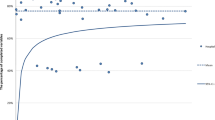Abstract
National databases, such as the Irish Hip Fracture Database (IHFD), are known to contain inaccuracies. The coordination of services, national funding and future research rely on the integrity of the IHFD so as to avoid policy and budget planning being based on misrepresentative data. An audit was performed to assess the accuracy of the 2016 IHFD data collected in our trauma unit. The Hospital In-Patient Enquiry (HIPE)-recorded fracture classification, IHFD-recorded fracture classification and IHFD-recorded operation performed for each hip fracture patient was identified. Each variable was compared with the classifications and procedures derived by the authors. Two hundred fifty-two cases were identified. The HIPE-recorded fracture classification was accurate in 29% of cases, and the IHFD-recorded fracture classification in 61% (p < 0.001). The IHFD-recorded operation performed was accurate in 76% of cases. Thirty-six cases (14%) were omitted by HIPE, and eight (3%) from the local IHFD (p < 0.001). Errors resulted from poor documentation, in determining the presence of fracture displacement, prosthesis coating and intramedullary nail length. Diagnoses and procedures were identified from ward and theatre logbooks that the data coordinator was unable to record. The data coordinator in our unit doubled the accuracy of the data, and reduced the rate of omitted cases by a factor of 4.5. Accuracy levels would be significantly improved with clear, thorough documentation by the medical team following education of junior surgical trainees on hip fracture classification and procedural coding. Inaccurate data has a negative effect on hospital reimbursement and compromises the integrity of the IHFD.
Similar content being viewed by others
References
Irish Hip Fracture Database (IHFD): (2015) Irish hip fracture database National Report 2013; better, safer care. National Office of clinical audit
Irish Hip Fracture Database (IHFD): (2016) Irish hip fracture database National Report 2015; better, safer care. National Office of Clincal audit
National Model of Care for Trauma and Orthopaedic Surgery. (2015)National Clincal Programme for Trauma and Orthopaedic Surgery
The Care of Patients with Fragility Fracture.(2007) British Orthopaedic Association
Strategy to prevent falls and fractures in Ireland’s ageing population: summary, conclusions and recommendations. (2008) Department Of Health, Health Service Executive
McGowan B, Casey MC, Silke C, Whelan B, Bennett K (2013) Hospitalisations for fracture and associated costs between 2000 and 2009 in Ireland: a trend analysis. Osteoporos Int 24(3):849–857
Edwards GAD, Metcalfe AJ, Johansen A, O’Doherty D (2010) Performance monitoring in hip fracture surgery—how big a database do we really need? Injury 41(4):374–376
Høiberg MP, Gram J, Hermann P, Brixen K, Haugeberg G (2014) The incidence of hip fractures in Norway—accuracy of the national Norwegian patient registry. BMC Musculoskelet Disord 15(13):372
Cundall-Curry DJ, Lawrence JE, Fountain DM, Gooding CR (2016) Data errors in the National Hip Fracture Database. Bone Joint J 98-B:1406–1409
Kosy JD, Kassam AAM, Hockings M (2013) National Joint Registry data inaccuracy: a threat to proper reporting. Br J Hosp Med (Lond) 74:691–693
HIPE Portal Data entry/Hip Fracture Admission (V4.0.2*). (2015) Healthcare Pricing. Office
Jones MA, Newell C, Howard PW. (2012) Comparison of revision hip and knee arthroplasty data accuracy in the NJR, HES and local theatre records. J Bone Joint Surg [Br]. ; 94-B (Suppl:xxix 2)
Palmer AJR, Dimbylow D, Giritharan S. (2012) How accurate is national joint registry data? J Bone Joint Surg [Br].94-B (Suppl xxix 73)
Green J, Wintfeld N (1993) How accurate are hospital discharge data for evaluating effectiveness of care? Med Care 31(719–31):719–731
Chesser TJS, Handley R (2017) Update of NICE guidance for hip fractures in adults. Hip Int 27(5):413–414
Garden RS (1961) Low-angle fixation in fractures of the femoral neck. J Bone Joint Surg (Br) 43(4):647–663
Integrated Care Pathway for Hip Fracture (2015) National Integrate Care Pathway Working Group. In: Health Service Executive
Kates SL (2016) Hip fracture programs: are they effective? Injury 47(S1):S25–SS7
Huttunen TT, Kannus P, Pihlajamäki H, Mattila VM (2014) Pertrochanteric fracture of the femur in the Finnish National Hospital Discharge Register: validity of procedural coding, external cause for injury and diagnosis. BMC Musculoskelet Disord 15:98
Phillips JRA, Boulton C, Moran CG, Manktelow ARJ (2011) What is the financial cost of treating periprosthetic hip fractures? Injury 42:146–149
Lawrence TM, White CT, Wenn R, Moran CG (2005) The current hospital costs of treating hip fractures. Injury 36:88–91
vanWalraven C, Austin P (2012) Administrative database research has unique characteristics that can risk biased results. J Clin Epidemiol 65(126–32)
Milburn JA, Driver CP, Youngson GG (2007) The accuracy of clinical data: a comparison between central and local data collection. Surgeon 5:275–278
Bergeron E, Lavoie A, Belcaid A, Ratte S, Clas D (2005) Should patients with isolated hip fractures be included in trauma registries? J Trauma 58(4):793–797
Ferguson KB, Halai M, Winter A, Elswood T, Smith R, Hutchison JD, Holt G (2016) National audits of hip fractures: are yearly audits required? Injury 47:439–443
Neuburger J, Currie C, Wakeman R, Tsang C, Plant F, Stavola BD et al (2015) The impact of a national clinician-led audit initiative on care and mortality after hip fracture in England: an external evaluation using time trends in non-audit data. Med Care 53:686–691
Funding
This study did not require any funding.
Author information
Authors and Affiliations
Corresponding author
Ethics declarations
Conflict of interest
The authors declare that they have no conflict of interest.
Ethical approval
This article does not contain any studies with human participants or animals performed by any of the authors.
Rights and permissions
About this article
Cite this article
Hughes, A.J., Hennessy, O., Brennan, L. et al. How accurate is the data provided to the Irish hip fracture database?. Ir J Med Sci 188, 13–18 (2019). https://doi.org/10.1007/s11845-018-1810-5
Received:
Accepted:
Published:
Issue Date:
DOI: https://doi.org/10.1007/s11845-018-1810-5




